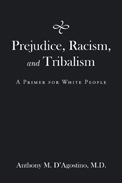
 |
Prejudice, Racism, and Tribalism: A Primer for White People
by Anthony M. D’Agostino, MD
Page Publishing
D’Agostino, a psychiatric and behavioral health expert, offers his personal and professional opinions about the differences between racism, prejudice, and tribalism in his book. He clearly explains in the introduction that he is neither a sociologist nor a scholar of racism, nor has he spent years researching and writing about this issue. His interest stems from his viewpoint as a mental health professional looking through the lens of psychiatric concerns with the complex of “motivations and emotionally important belief systems.” To this end, the author primarily examines the trajectory of race relations in his lifetime as he experienced the black-white racial divide, although he also cogently covers the topic historically.
D’Agostino digs deep into defining and examining the various degrees and definitions of racism, as the title suggests. He feels that “an overly broad definition of racism is counterproductive in several ways” due to a tendency to dilute the historical and contemporary impacts of racial prejudice in America. The twenty-two chapters of the volume are dedicated to defining the differences the author perceives between prejudice, racism, and tribalism as related to race and cultural relations. He also examines the similarities in acceptance of or prejudice toward Indigenous people, women, LGBTQ and transgendered people, and the plight of undocumented immigrants from Central and South America in American society.
D’Agostino is clear about his personal experiences during his childhood and coming of age in a conservative Italian Catholic family and how Catholic schools influenced his outlook. Because of his close proximity to Catholicism, the author also delves into the spiritual aspects of racism and prejudice, and he is well-qualified to comment on the differences between the contemporary Catholic viewpoint as contrasted with the contemporary Evangelical Christian viewpoint.
Despite D’Agostino’s humble assessment of his research skills, the narrative has a robust bibliography regardless of the fairly minimal number of citations in the text, so he is clearly interested in other more academically oriented definitive texts. He discusses the work of some highly influential scholars and social justice activists. His discussion of the various permutations of racism and prejudice is highly accessible to the lay reader, who will feel comforted by the matter-of-fact tone one would expect of a trusted counselor or a community elder with great knowledge of this complicated and often uncomfortable and incendiary subject matter.
At times, the author seems a bit distant or cavalier about topics such as slavery, which often elicit either strong guilt or strong denial in White Americans despite the time and distance elapsed since the emergence of colonial conquest and exploitation and the enslavement of Africans and others. In reality, slavery was also practiced concurrently by the most affluent people of nearly all races and cultures in the past. D’Agostino takes the viewpoint that there is no point in feeling guilty for a practice that one did not directly participate in or sanction, nor should anyone feel guilt when they discover a slave owner in their ancestry. Rather, it is shame that can and should be felt, he proposes, and shame may be used as a motivating emotion to improve human society. D’Agostino takes a softer line as he explores the difference between guilt and shame, though he seems somewhat ambiguous about the currently popular concept of reparations, which he sees as not particularly important. That said, D’Agostino is quite clear about the influences of his personal experiences as a Euro-American and is thorough in his thematic explorations, leaving no stone unturned. Readers will feel as if the author’s reasonable stances make him amenable to his own course correction.
The author takes his discussion beyond the usual parameters of race, addressing how prejudice and politics affect economic considerations in the healthcare and pharmaceutical industries, two topics that are inextricably linked to his experiences as a mental healthcare provider. D’Agostino’s thoughtful, frank manner of writing smooths a pathway to a reasonable and clear discussion of the vast territory covered in his book despite any reservations or disagreements that readers may have with his opinions. The greatest portion of the narrative is logical and reasonable, despite the author’s privilege of birth into a white subculture that ironically struggled with its fair share of prejudice in mid-twentieth-century America. This is not a highly controversial narrative that will shock, exploit, or offend the sensibilities of reasonable readers. Instead, it intends to foster clarity and smooth the rough path ahead toward more hard-earned social change in America.
RECOMMENDED by the US Review